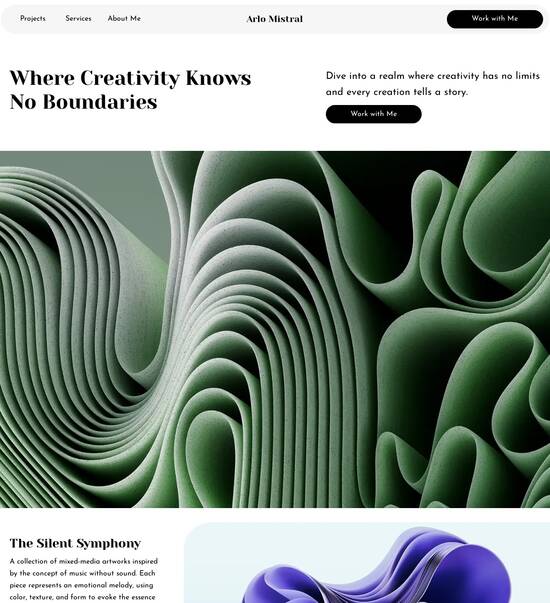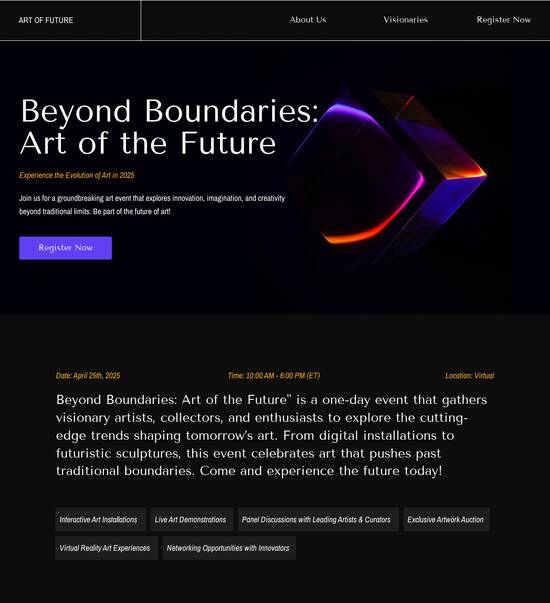
Product page template for Risk managers
Explore Similar TemplatesAbout template
Master your online marketing with this builder for product page template for Risk managers. Try more tools to create an immaculate landing page.
Recommended templates

Easy to build without coding
With the intuitive drag-and-drop builder, anyone on your team can create high-converting pages without any knowledge of code or design. Make enhancements to your landing page with custom widgets using Javascript, HTML/CSS, or third-party scripts.

Multiple layouts for any industry and goal
Select from 500+ landing page layouts built to boost conversions across industry-specific scenarios. Customize them by adjusting fonts, adding images, and generating on-brand content with the AI assistant. Quickly scale with Instablocks® and Global Blocks that you can save, reuse, and update globally.

Loads fast and looks polished on any device
Every template is responsive, which means they present professionally on any device and load blazingly fast with our Thor Render Engine. You can also power them up with Google AMP technology to deliver an unparalleled mobile experience and drive higher conversions.

Robust analytics & experimentation
Get real-time updates and reporting across all your devices, showing the number of visitors, conversions, cost-per-visitor, and cost-per-lead. Launch AI-powered experiments, run A/B tests, and use heatmaps to analyze user behavior, then optimize your landing page to maximize conversions.







Easy to build without coding
With the intuitive drag-and-drop builder, anyone on your team can create high-converting pages without any knowledge of code or design. Make enhancements to your landing page with custom widgets using Javascript, HTML/CSS, or third-party scripts.
Multiple layouts for any industry and goal
Select from 500+ landing page layouts built to boost conversions across industry-specific scenarios. Customize them by adjusting fonts, adding images, and generating on-brand content with the AI assistant. Quickly scale with Instablocks® and Global Blocks that you can save, reuse, and update globally.
Loads fast and looks polished on any device
Every template is responsive, which means they present professionally on any device and load blazingly fast with our Thor Render Engine.
Robust analytics & experimentation
Get real-time updates and reporting across all your devices, showing the number of visitors, conversions, cost-per-visitor, and cost-per-lead. Launch AI-powered experiments, run A/B tests, and use heatmaps to analyze user behavior, then optimize your landing page to maximize conversions.
All the features you need to build lead-generating landing pages
Explore more featuresLearn how to build top-performing landing pages for any goal
FAQs
Leading the way in building high-performing landing pages





Optimize your digital marketing with Instapage landing page templates for risk managers
Creating effective landing pages is crucial for risk managers looking to streamline their marketing efforts and convert leads. Instapage’s powerful platform offers flexibility, performance optimization, and personalization that can significantly improve your campaign outcomes. In this guide, we’ll walk you through how to use Instapage’s templates tailored for risk managers effectively, enhancing your lead generation and ROI.
Understanding the importance of landing pages for risk management
Landing pages serve as critical touchpoints between your audience and your offerings. For risk managers, it’s essential to capture interest and provide clear information. By using Instapage, you can take advantage of over 100 high-converting templates designed specifically to cater to various scenarios within risk management, all without requiring extensive design skills.
- Conversion-optimized layouts enhance the likelihood of lead capture.
- Customizable elements allow you to adapt templates to reflect your branding.
- Analytics integration helps monitor visitor behavior and improve page performance.
Step one: Select the right landing page template
Begin by exploring the extensive library of templates available in Instapage. Choose one that aligns with the objectives of your campaign—whether it’s promoting a new risk assessment service or providing informative resources. The design should resonate with your target audience, ensuring clarity and accessibility.
Step two: Customize your landing page for maximum impact
Once you have selected a template, it’s time to customize it to meet your specific needs. Use Instapage's intuitive drag-and-drop builder to incorporate your branding, messaging, and lead generation elements.
- Add compliance information relevant to your services.
- Customize CTAs to reflect urgency (e.g., 'Get your risk analysis today!').
- Incorporate testimonials or case studies to build trust.
Step three: Optimize and launch your landing page
With your page customized, utilize Instapage’s A/B testing features to experiment with different headlines, images, and CTAs. The analytics dashboard will provide insights into visitor behavior, helping you refine your approach post-launch.
- Test various lead capture form placements for the best performance.
- Analyze heatmaps to understand where users engage most.
- Adjust content based on performance metrics to enhance conversion rates.
By following these steps, you will be well-equipped to create landing pages that convert effectively for risk management campaigns.
Ready to transform your marketing campaigns? Explore Instapage today and discover how easy it is to create compelling landing pages designed for informed decision-making in risk management.
People also ask about Product page template for Risk managers
Understanding the complex landscape of risk management through effective product page templates
The changing role of risk managers in modern project management
Risk management has significantly evolved in the last few decades. Historically, risk management was often a reactive process, focusing on avoiding negative impacts after they had occurred. However, as businesses face increasingly complex environments characterized by rapid technological changes and global competition, the role of risk managers has transformed. They are now expected to take a proactive stance, identifying potential risks before they escalate. This shift has integrated risk management into the core framework of project management, emphasizing the importance of strategic foresight.
The importance of structured templates in risk management cannot be overstated. Standardization not only enhances the efficiency of risk documentation but also facilitates clearer communication and collaboration among teams. With a structured approach, risk managers can quickly share information with stakeholders, ensuring everyone is aligned with the project’s objectives. Consequently, teams can act swiftly to mitigate identified risks, thereby improving overall project outcomes.
Key components of an effective risk management plan template
An effective risk management plan template should include several foundational sections that guide the risk management process. An executive summary at the beginning not only outlines the approach but also sets the tone for the project's risk management framework. The objectives and scope will define what aspects of the project are covered, helping teams focus their efforts where they are most needed.
Furthermore, a detailed breakdown of essential risks is critical. This includes identifying various project risks with clear definitions and categorizations. Whether it’s technical, operational, or financial risks, proper categorization aids in developing effective responses. Additionally, conducting a risk impact analysis is crucial for understanding the significance of each risk in the context of project planning.
Utilizing project management templates to mitigate risks
There are different project management templates designed specifically for risk management purposes. For instance, templates for risk assessments and response plans serve as valuable resources for teams. By customizing these templates, project managers can tailor them to fit their specific project requirements, ensuring relevance and practicality. This adaptability is key in today’s fast-paced project environments.
A risk matrix is another vital tool within project templates. It involves the evaluation of risk elements based on probability, impact, and severity. By utilizing a risk matrix, managers can visualize the risks associated with their projects, prioritizing them effectively. When created and utilized correctly, a risk matrix helps teams make informed decisions, ensuring that potential problems are addressed proactively.
The role of teams in developing and executing risk management plans
Building a risk-aware culture within teams is essential for effective risk management. Engaging team members in risk identification processes not only enhances collaborative efforts but also fosters a sense of ownership. When team members are actively involved, they are more likely to contribute meaningfully to risk mitigation, thus improving the overall effectiveness of the risk management plan.
Another critical aspect is the clear delineation of roles and responsibilities within the risk management plan. By assigning specific tasks, project managers ensure that accountability is maintained. Utilizing tools for tracking and reporting on assigned tasks can greatly enhance visibility, allowing teams to monitor progress and address issues as they arise.
Identifying and analyzing risks effectively
Comprehensive techniques for risk identification include brainstorming, surveys, and expert consultations. These methods enable teams to gather diverse perspectives, which can unveil potential risks that may not have been considered. Moreover, utilizing historical data can assist in anticipating project risks based on past experiences. Such proactive measures help create a more resilient risk management framework.
Qualitative and quantitative risk analysis methods are invaluable for assessing identified risks. Qualitative methods provide insights into the perceived severity of risks, while quantitative analysis assesses their potential impacts numerically. Understanding the advantages and disadvantages of different analysis techniques allows teams to select the most appropriate methods for their projects. By integrating these analysis outcomes into their risk management plans, teams enhance their ability to respond to risks effectively.
Implementing robust risk mitigation strategies
Developing actionable risk mitigation strategies requires categorization based on several approaches, including avoidance, transfer, acceptance, and mitigation. For instance, avoiding a risk might involve altering project plans while transferring a risk could entail outsourcing certain elements to third-party vendors. Successful risk mitigation strategies often stem from hindsight and lessons learned from previous projects, providing valuable insights for future endeavors.
Moreover, continuous monitoring and adjustment of risk strategies is essential. A flexible risk response plan allows project managers to adapt to changing circumstances. Techniques for ongoing risk assessment might include regular team check-ins or utilizing software tools designed for real-time monitoring. Such a proactive approach ensures that risk strategies remain relevant and effective.
Streamlining request and approval processes for risk management
Creating efficient request templates for risk management changes is crucial for maintaining smooth operations. Standardizing risk change requests with clearly defined key components can significantly expedite the approval process. When team members understand what is required in a request, they are more likely to submit concise and accurate information.
Best practices for reviewing and approving risk management plans include establishing clear criteria for evaluation. Engaging stakeholders during the approval process is also beneficial as it fosters transparency and collective ownership of decisions. This collaborative approach not only builds trust but also enhances the likelihood of successful plan implementation.
Technology-supported risk management: tools and software integration
The impact of technology on risk management efficiency has been transformative. Software tools available today enhance various aspects of risk management, from identification to reporting. Incorporating technology into project risk management provides teams with resources that streamline processes, enabling quicker responses to changing risk landscapes.
Case studies of technology-enabled risk management processes highlight the effectiveness of such integrations. For example, IT projects utilizing advanced risk management software reported improved risk identification and mitigation practices. Insights gained from these successful implementations can provide a roadmap for future projects looking to leverage innovative software solutions.
The future of risk management templates in project planning
Trends shaping the future of risk management in projects reflect an ongoing evolution of templates influenced by technological advancements. As tools and methodologies improve, the roles and responsibilities of risk managers will likely expand to encompass new areas of focus. Adapting to these changes will be essential for professionals aiming to enhance their effectiveness in managing project risks.
The potential for customization and flexibility in risk templates will continue to grow. Exploring developments in artificial intelligence and machine learning could revolutionize how risks are assessed and managed in projects. By moving away from one-size-fits-all templates, organizations can tailor their approaches to suit unique project circumstances, thereby improving overall project outcomes.
Leveraging best practices from industry leaders
Insights from organizations successfully implementing risk management templates can provide valuable lessons. Studying diverse industry applications offers a wealth of knowledge on effective template usage and customization strategies. Key takeaways from their experiences can help others avoid common pitfalls and refine their own risk management practices.
Developing a personalized approach based on industry-specific needs can be a game changer. Tailoring templates to meet unique organizational challenges encourages innovation and responsiveness. Collaborative feedback on template design ensures that formats remain relevant and practical, ultimately driving better project outcomes.
Ready to skyrocket conversions?
Supercharge your ad campaigns with high-performing landing pages
Get started














